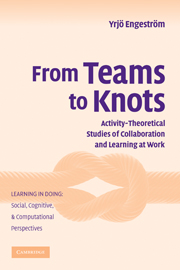Book contents
- Frontmatter
- Contents
- Series Foreword
- Preface
- 1 Teams and the Transformation of Work
- 2 Disturbance Management and Masking in a Television Production Team
- 3 Teamwork between Adversaries: Coordination, Cooperation, and Communication in a Court Trial
- 4 Displacement and Innovation in Primary Care Medical Teams
- 5 Crossing Boundaries in Teacher Teams
- 6 Knowledge Creation in Industrial Work Teams
- 7 Teams, Infrastructures, and Social Capital
- 8 From Iron Cages to Webs on the Wind
- 9 Knotworking and Agency in Fluid Organizational Fields
- References
- Author Index
- Subject Index
- Titles in the series
3 - Teamwork between Adversaries: Coordination, Cooperation, and Communication in a Court Trial
Published online by Cambridge University Press: 05 June 2012
- Frontmatter
- Contents
- Series Foreword
- Preface
- 1 Teams and the Transformation of Work
- 2 Disturbance Management and Masking in a Television Production Team
- 3 Teamwork between Adversaries: Coordination, Cooperation, and Communication in a Court Trial
- 4 Displacement and Innovation in Primary Care Medical Teams
- 5 Crossing Boundaries in Teacher Teams
- 6 Knowledge Creation in Industrial Work Teams
- 7 Teams, Infrastructures, and Social Capital
- 8 From Iron Cages to Webs on the Wind
- 9 Knotworking and Agency in Fluid Organizational Fields
- References
- Author Index
- Subject Index
- Titles in the series
Summary
In Chapter 2, I showed how stagnation and defensive encapsulation took hold of a team even though the team was ostensibly successfully engaged in creative work. In this chapter, I will analyze an almost opposite phenomenon: How do new possibilities for expanded dialogue and innovation emerge in a highly rule-based team engaged in what is commonly not regarded as particularly creative work?
Work in courts of law is historically heavily anchored in the individual craft skills and idiosyncratic personalities of the judge and the attorneys. On the other hand, work in courts of law is also among the most formal and rule-based processes in industrialized societies. In this sense, court work is a peculiar blend of autonomous, tacit craft and highly codified and standardized bureaucratic mass production.
However, the intricate division of labor in court organizations and the increasing complexity of cases give rise to various kinds of disturbances and unexpected contingencies in interactions inside and outside the courtroom. In the United States, as in many other countries, courts face rapidly growing caseloads with much less impressive growth in the number of judges and other personnel. As Heydebrand and Seron (1990) show, the way to cope with this dilemma has been increasing rationalization. Such rationalization includes novel scheduling techniques as well as increasing reliance on magistrates, probation officers, and law clerks instead of judges alone. Most importantly, it includes new mechanisms for resolving and settling cases before they reach the stage of a full-scale jury trial.
- Type
- Chapter
- Information
- From Teams to KnotsActivity-Theoretical Studies of Collaboration and Learning at Work, pp. 48 - 63Publisher: Cambridge University PressPrint publication year: 2008
- 1
- Cited by

